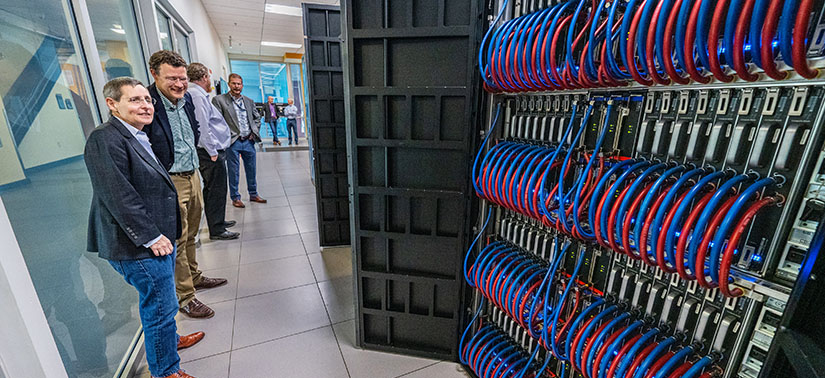NREL Joins $40 Million Effort To Advance Data Center Cooling Efficiency
ARPA-E Program Creates More Energy-Efficient Data Centers, Reducing Carbon Emissions and Mitigating Climate Change

The National Renewable Energy Laboratory (NREL) joined a $40 million program led by the U.S. Department of Energy's Advanced Research Projects Agency-Energy (ARPA-E) to radically rethink how components within data centers are cooled.
Among the 15 ARPA-E projects selected, NREL has been named as the lead on one research project and is supporting three additional projects within the ARPA-E Cooling Operations Optimized for Leaps in Energy, Reliability, and Carbon Hyperefficiency for Information Processing Systems (COOLERCHIPS) program.
The selected COOLERCHIPS projects—with partners from national laboratories, universities, and industry—are exploring how to reduce the energy required to power and cool data centers. These efforts will lower the operational carbon footprint associated with this critical infrastructure and support ambitious clean energy goals to reach net-zero carbon by 2050.
Importance of Efficient Cooling in Data Centers
Data centers power our virtual environment. These facilities house high-performance computers, storage systems, and computing infrastructure but account for approximately 2% of all electricity consumption in the United States. The energy usage required for just one data center is comparable to powering 80,000 households—roughly the number of total households in Montgomery, Alabama. Cooling accounts for up to 40% of energy usage in data centers, making efficient cooling strategies vital.
NREL is a living laboratory where cutting-edge concepts are deployed on campus to show real-world applications. For NREL buildings researchers, high-performance computing is necessary for modeling and simulations, allowing researchers to analyze very large data sets and control complex systems to better understand real-world applications. For example, in the End-Use Load Profiles project, building energy consumption is modeled using the supercomputer Eagle to inform decision makers and help answer the "What ifs" surrounding decarbonization measures in buildings across the country. NREL's supercomputer supported approximately 900,000 building energy models, each representing one year of energy consumption, across various buildings and climates, in 15-minute intervals, separated into end-use categories.
To efficiently cool the supercomputer on NREL's South Table Mountain Campus in Golden, Colorado, a warm-water liquid-cooling method captures 97% of its waste heat and is then made available for use throughout the Energy Systems Integration Facility (ESIF) that houses the data center. Heated water is integrated directly into the main thermal system of the building and provides the primary source of heat for ESIF's office and lab spaces—and is even used to de-ice the sidewalks outside of ESIF in the winter. With this efficient cooling method, just under 2 MW of electrical power is required to operate Eagle.
Standardizing the Evaluation of Cooling Technology
NREL researcher David Sickinger is leading a more than $1.5 million ARPA-E project with the Georgia Institute of Technology (Georgia Tech) and Sandia National Laboratories to serve as the COOLERCHIPS Technical Evaluation Team.
The group will develop standardized testing to evaluate the cooling technologies developed by COOLERCHIPS projects in real data center operating conditions. The scale will range from the component level to the rack level and all the way up to full-edge data centers. These highly standardized methods for measuring metrics can be used by all partners. NREL and Georgia Tech also plan to host some of the newly developed systems from the COOLERCHIPS research teams and will assist in evaluating their cooling solutions.
NREL Partner Awards
NREL's Sreekant Narumanchi, who leads the laboratory's world-class advanced power electronics and electric machines research, and his team will be key contributors to several of the COOLERCHIPS partner projects. These include:
-
The University of Missouri earned $1.6 million to develop a hybrid mechanical-capillary-driven two-phase loop to serve as a cooling solution for data centers. The proposed technology offers numerous advantages over existing phase-change processes such as flow boiling and condensation, including dual-mode operation, low thermal resistance, high heat flux, low pumping power consumption, high power density, reliable operation, and a fully scalable design. NREL's involvement is being led by senior research engineer Douglas DeVoto.
-
The University of Maryland earned $3.5 million to develop an integrated decision support software tool for the design of next-generation data centers that seamlessly links the existing open-source software for modeling reliability, energy, carbon footprint, and cost with an innovative cosimulation framework. This tool will permit data center designers to develop transformational and disruptive design advances compared to existing state-of-the-art technologies. NREL support will be led by NREL research engineer Jiazhen Ling.
-
The University of Florida earned $3 million to develop a disruptive thermal management solution proposed for cooling future CPU and GPU chips at unprecedented heat flux and power levels in data center server racks. The new technology allows for significant future growth in processor power, rejects heat directly to the ambient air external to the data center, and facilitates adoption within the existing data center infrastructure with a primary liquid cooling loop. The NREL project lead is senior research engineer Gilbert Moreno.
About COOLERCHIPS
COOLERCHIPS aims to reduce total cooling energy expenditure to less than 5% of a typical data center's IT load at any time and in any U.S. location for a high-density computing system. Raising the technological bar to reduce data center cooling energy will decrease the operational CO2 footprint, improve center security, and reduce operational costs.
Learn more about ARPA-E and the projects selected as part of the COOLERCHIPS program.
Last Updated May 28, 2025
